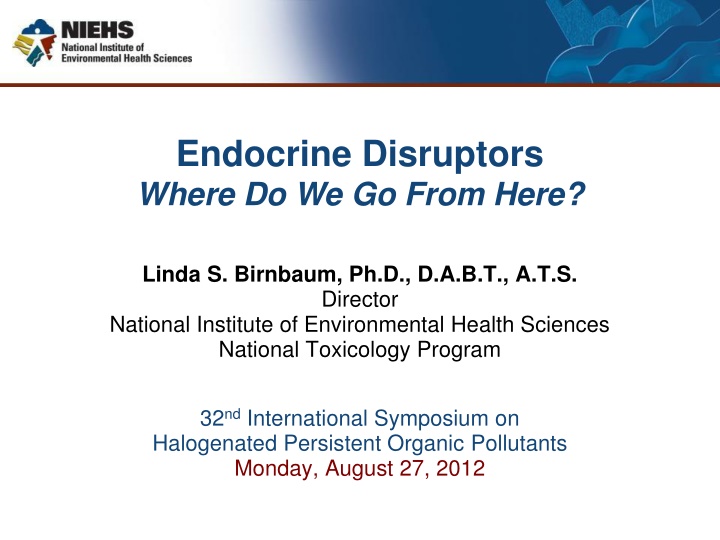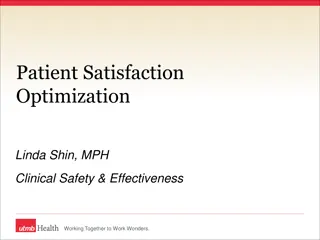
Impact of Endocrine Disruptors on Health and Disease
Explore the influence of environmental factors on diseases like diabetes, autism, and asthma, and the role of endocrine disruptors in these health conditions. Learn about the complex interplay between genes, environment, and the endocrine system in disease development.
Download Presentation

Please find below an Image/Link to download the presentation.
The content on the website is provided AS IS for your information and personal use only. It may not be sold, licensed, or shared on other websites without obtaining consent from the author. If you encounter any issues during the download, it is possible that the publisher has removed the file from their server.
You are allowed to download the files provided on this website for personal or commercial use, subject to the condition that they are used lawfully. All files are the property of their respective owners.
The content on the website is provided AS IS for your information and personal use only. It may not be sold, licensed, or shared on other websites without obtaining consent from the author.
E N D
Presentation Transcript
Endocrine Disruptors Where Do We Go From Here? Linda S. Birnbaum, Ph.D., D.A.B.T., A.T.S. Director National Institute of Environmental Health Sciences National Toxicology Program 32ndInternational Symposium on Halogenated Persistent Organic Pollutants Monday, August 27, 2012
Should We Be Concerned? Sharpe and Irvine, 2004
Should We Be Concerned? Increase in Diabetes (1980-2010) Increase in Autism Prevalence Increase in Asthma Increase in ADHD Data from CDC / National Center for Health Statistics
Gene-Environment and Disease Why have some diseases increased in incidence over the past 40 years? Genes have not changed over that time Recent epidemics of diabetes, asthma, ADHD, obesity due to environmental, dietary and behavioral changes We will never understand the etiology of diseases without an understanding of the role of environment
ENVIRONMENT Includes: Industrial chemicals Foods and nutrients Agricultural chemicals Prescription drugs Physical agents (heat, radiation) Lifestyle choices and substance abuse By-products of combustion and industrial processes (dioxin) Social and economic factors Infectious agents Microbiome (gut flora)
Diseases with a Known or Suspected Environmental Component Include: Cancers Birth defects (cleft palate, cardiac malformations) Reproductive dysfunction (infertility) Lung dysfunction (asthma, asbestosis) Neurodegenerative diseases (Parkinson s) Neurodevelopmental disorders (autism)
The Endocrine System Complex system of hormones and receptors - Multiple receptors (cellular/nuclear) - Multiple cofactors - Receptor cross-talk - Hormones active at pM-nM concentrations - SERMs Multiple modes of action over a wide dose response - Non-monotonic dose responses - High doses do not predict low dose effects - High doses cause negative feedback Doses examined must be in the range of agent binding to receptor system Highly conserved across species
Some Chemicals Disrupt the Endocrine System Endocrine Disruptors Exogenous agents that interfere with the production, release, transport, metabolism, binding, action, or elimination of the natural hormones in the body responsible for the maintenance of homeostasis and the regulation of developmental processes EPA definition modified from Crisp et al, Environmental Endocrine Disruption: An Effects Assessment and Analysis, EHP 1998.
Why We Study Endocrine Disrupting Chemicals Low doses can have big effects Wide range of effects on our health Early life exposures can have persistent effects Endocrine disrupting chemicals are ubiquitous Effects seen in wildlife, laboratory animals, and people
Endocrine Disrupting Chemicals HERBICIDES 2,4,-D 2,4,5,-T Alachlor Amitrole Atrazine Linuron Metribuzin Nitrofen Trifluralin INSECTICIDES Aldicarb beta-HCH Carbaryl Chlordane Chlordecone DBCP Dicofol Dieldrin DDT and metabolites Endosulfan Heptachlor / H-epoxide Lindane (gamma-HCH) Malathion Methomyl Methoxychlor Oxychlordane Parathion Synthetic pyrethroids Transnonachlor Toxaphene INDUSTRIAL CHEMICALS Bisphenol - A Polycarbonates Butylhydroxyanisole (BHA) Cadmium Chloro- & Bromo-diphenyl Dioxins Furans Lead Manganese Methyl mercury Nonylphenol Octylphenol PBDEs PCBs Pentachlorophenol Penta- to Nonylphenols Perchlorate PFOA p-tert-Pentylphenol Phthalates Styrene FUNGICIDES Benomyl Ethylene thiourea Fenarimol Hexachlorobenzene Mancozeb Maneb Metiram - complex Tri-butyl-tin Vinclozolin Zineb Testosterone synthesis inhibitor Estrogen receptor agonist Thyroid hormone disruptor METALS Androgen receptor antagonist
Low Dose Our endocrine system: tiny amounts of hormones with profound effects on development and normal health Chemical exposures, even at low doses, can disrupt delicate endocrine system and create a mechanism for disease For some endocrine disruptors, biological changes can be seen at low doses, but not at high doses For example: BPA, atrazine, DDT, DES, dioxin (TCDD), genistein, nicotine, parathion, PBDE-99, PCB mixtures, perchlorate, sodium fluoride, triclosan, and others
Non-Monotonic Dose-Response Curves NMDRCs in Endocrine Disruptors NMDRCs in hormones Atrazine Bisphenol A (BPA) Chlorpyrifos DDT DES Dioxin (TCDD) PBDE-99 PCB 180 and PCB Mixtures Perchlorate Sodium fluoride Tributylin oxide Triclosan Cortisol Estradiol Progesterone Insulin Growth Hormone Prolactin Testosterone Thyroid Hormone TSH And others
A Practical Example: Tamoxifen Flare True NOAEL Flare NOAEL SAFE SAFE Modified from Vandenberg et al, Hormones and EDCs: Low-Dose Effects and Nonmonotonic Dose Responses, Endocrine Reviews 2012.
Example: Leptin Modified from Vandenberg et al, Hormones and EDCs: Low-Dose Effects and Nonmonotonic Dose Responses, Endocrine Reviews 2012.
Wide Range of Health Effects Endocrine signals govern every organ & process in body When chemicals interfere, effects can be seen in many different conditions and diseases Recent work on endocrine disruption shows potential health effects including immune function, metabolism, brain development and behavior. Animal studies identified exposure to environmental endocrine disruptors can cause weight gain later in life. Endocrine Disruptors have also been linked to cancers, altered behavior, diabetes, immune dysfunction, reproductive dysfunction, and cardiovascular disease
Decreasing Age of Puberty US expert panel concluded: Age of Menarche in Europe and the US from 1790 to 1980 Earlier breast development and onset of menarche Suggest endocrine- disrupting chemicals and body fat are important factors associated with the change African American and Mexican American girls enter puberty earlier than white girls Euling et al. Pediatrics 2008.
Decreasing Age of Puberty The proportion of white girls in the Breast Cancer and the Environment Research Consortium who attained breast stage >2 at age 7 years significantly greater than reported in Pediatric Research in Office Settings (PROS) network in 1997. White girls: 10.4% vs 5.0% (z = 3.72, P = .001) Black non-Hispanic girls: 23.4% vs 15.4% (not significant) The proportion of white girls at breast stage >2 at age 8 also significantly greater than PROS. White girls: 17.9% vs 10.5% (z = 3.77, P < .0002) Black non-Hispanic girls: 37.0% vs 36.6% (not significant) Biro et al, Pediatrics 2010.
Decreasing Age of Puberty Exposure to three chemical classes (phenols, phthalates, and phytoestrogens) in multiethnic longitudinal study of 1,151 girls: High-molecular-weight phthalate metabolites and triclosan weakly associated with pubic hair development Daidzein with breast stage Low-molecular-weight phthalate biomarkers associated with breast and pubic hair development Enterolactone attenuated BMI associations with breast development Weak, hormonally active xenobiotic agents had small associations with pubertal development, mainly agents detected at highest concentrations. Wolff et al,EHP 2010
Phthalates and Anogenital Distance Higher exposure to phthalates (phthalate score) results in lower anogenital index (AGI) in boys. Association between AGI and phthalate exposure consistent with phthalate-related syndrome reported in prenatally exposed rodents. Data support hypothesis that prenatal phthalate exposure at environmental levels adversely affects male reproductive development. Swann et al, 2005. EHP;113(8):1056 1061
Bisphenol A & Diabetes / Obesity (Human Studies) BPA and Diabetes, Glucose Homeostatis, Obesity NTP Review of 8 Studies Studies range from 2008 2011 Risk Estimates show: All Odds Ratios > 1.00 for diabetes All OR > 1.00 for glucose homeostatis All OR > 1.00 for overweight & obesity No pooled OR available yet
Persistence of Biological Effects Health effects of exposure to endocrine disruptors can be observed long after the actual exposure has stopped This is especially true when exposures occur during growth and development, processes that are very sensitive to endocrine regulation Epigenetics: the study of changes in DNA expression that are independent of the DNA sequence. A person s DNA base sequence doesn t change, but expression of DNA is affected by changes in DNA packaging. Environment is critical factor in DNA expression; we re born with genes, but environment affects epigenetic changes.
Windows of Susceptibility Early Prenatal Mid-Late Prenatal Central nervous system (3 wks - 20 yrs) Postnatal Ear (4-20 wks) Kidneys (4-40 wks) Heart (3-8 wks) Limbs (4-8 wks) Immune system (8-40 wks; competence & memory birth-10 yrs) Skeleton (1-12 wks) Lungs (3-40 wks; alveoli birth-10 yrs) Reproductive system (7-40 wks; maturation in puberty) Week 1-16 Week 17-40 Birth 25 years Source: Altshuler, K; Berg, M et al. Critical Periods in Development, OCHP Paper Series on Children's Health and the Environment, February 2003.
Examples of Developmental Origins of Health and Disease (DOHAD) Developmental Exposures Learning Differences/Behavior Asthma Increased Sensitivity to Infections Testicular Dysgenesis Syndrome Atherosclerosis Cardiovascular Disease Breast Cancer Infertility Obesity Prostate Cancer Alzheimer's Parkinson's Altered Puberty Fibroids Premature Menopause AGE 2 12 25 40 60 70
Windows of Susceptibility: Tobacco Maternal Smoking & Children s Obesity NTP Review of 23 Studies Studies range from 2001 2010 Pooled data show: OR=1.5 for obesity (95%CI=1.35-1.65) OR=1.6 for overweight (95%CI=1.42-1.90)
Ubiquitous Exposure Chemicals with endocrine disrupting activity are widely dispersed in our environment Endocrine disruptors often dispersed at biologically effective levels, and exposure to humans is common CDC s Report Card All of us exposed to many different chemicals, and other environmental stressors, at the same time Synergism Given exposures can alter the body s response to later exposures The exposome is the totality of exposures that a person is subjected to from the environment ( EWAS )
Summary: Where We Go From Here Need to better characterize: Low dose / nonmonotonic effects Early life exposures may not show effects until later in life Modes of action change across dose response Wide range of biological effects Assessment of new endocrine related endpoints may be needed Individual vs. public health risks Environmental health assessments are at individual level Population effects can be much larger Regulatory issues
Thank you! NIEHS Strategic Plan Website http://www.niehs.nih.gov/strategicplan





















